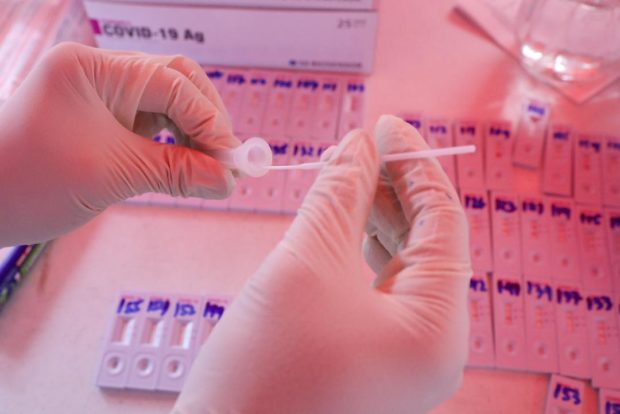
A medical technician takes a sample at the OVP’s Swab Cab project, which offers a free COVID-19 test to the public, on Wednesday, January 5, 2022, at Tandang Sora Avenue corner Visayas Avenue Extension in Quezon City. OVP Photo
MANILA, Philippines — Daily reported COVID-19 cases during the week of the May 9 national elections remained below 200 and were mostly mild or asymptomatic cases, while hospital admissions stayed at low-risk levels, the Department of Health (DOH) said on Monday.
The DOH weekly bulletin reported 1,118 new coronavirus infections detected by laboratory tests last week, or an average of 160 daily cases, which was marginally lower than the caseload in the week before the elections.
Of the 1,118 latest detected cases, 14 were severely or critically ill, according to the DOH.
The DOH confirmed 16 more deaths due to COVID-19, 12 of whom died within the month of May while four passed away in April.
This brought the country’s COVID-19 death toll to 60,455 out of 3,688,132 confirmed cases since the start of the pandemic two years ago.
According to the DOH, 438, or 15.6 percent, of the COVID-19 intensive care unit (ICU) beds were occupied, while 4,141 or 17.5 percent of the 23,707 non-ICU beds allocated for COVID-19 patients were in use.
There were at least 588 severe and critical cases among COVID-19 patients admitted in hospitals.
As of May 15, 68.6 million individuals were already fully vaccinated against COVID-19. Among the fully vaccinated, 13.6 million have received their booster or additional dose.
Vigilance
Despite the low numbers and the waning threat of a postelection surge of COVID-19 cases, experts on Monday supported the continuing imposition of alert levels as a way to maintain vigilance against the possible entry and spread of more transmissible Omicron subvariants.
Speaking at the Laging Handa public briefing, Dr. Edsel Salvana, a member of the technical working group of the government’s inter-agency task force on pandemic response, said there was “no indication” that cases were rising due to the crowded rallies during the campaign period and the massing at polling precincts on Election Day.
“[R]ight now, the numbers remain manageable. And even if the numbers do go up to several thousand, because of the high vaccination rate the number of people who actually developed severe disease remained low. So we really won’t return to the lockdowns of 2020 when our population had no immunity yet,” he added.
Guido David of Octa Research, another guest in the program, also said there was no indication of clustering of cases following the May 9 elections.
“With the low number of cases we can say that the risk of a surge due to the May 9 elections is low, but the game changer there is that the new subvariants that we’re monitoring. If they enter [the country], the trajectory of cases may change. But in terms of mass gatherings [that happened] in the election, we don’t see any surge and if the cases continue to decrease, we can say that it (election) did not cause a spike,” he said.
Salvana, an infectious disease specialist and molecular biologist, said he believed any possible rise in case “looks manageable for now.”
“It’s really more important that more people get boosted, at least only once, because that would be a big help in preventing surges. And even if there is a surge, we’ll have a low number of people who will have severe disease and our hospitals will remain open,” he said.
David backed the placing of the country under the lower alert levels, noting that there was no threat of a surge despite the detection of subvariants in some places.
“Our alert level system is flexible. If we see any increase, they can change the alert level. But as of now, we don’t see any threat [of a surge],” he said.
Economic cost
On the detection of the Omicron subvariants in the country, Salvana said it was noteworthy that the cases had not risen yet.
“I don’t see any indication that there are areas where the rate of increase is really fast, to the point that their health-care system would be overwhelmed,” he said.
“We have metrics [which we take into account] when to raise [the alert level]. If we restrict, there is a cost on our economy, there is also cost on the people—it costs jobs. And so, what we really want to do is [to be] able to live with the virus, balance the health of the economy and the means to do this really is to increase vaccination rates and booster coverage, and retaining the mask mandate because this contributes to the low number of cases in the community,” he said.
David, for his part, said there was a “little” clustering of cases occurring at the time the subvariants were detected, but he added the spikes “were not sustained and immediately plunged.”
“It probably means our wall of immunity remains strong due to vaccines and natural immunity. But, again, we can’t say that definitely because there might be a spike of cases in the next few weeks, which is why we’re monitoring thoroughly,” he said.
David said that for him, the average 200 cases a day recorded in the country, even if it increases to 250 a day, was “not significant.”
What could be concerning, he said, is if the daily cases reached 400 to 500 a day which might indicate a surge.
RELATED STORIES
Expert expects COVID-19 surge due to election activities
DOH wary of Omicron variant surge
DOH says COVID surge by May if protocols aren’t met is just a projection